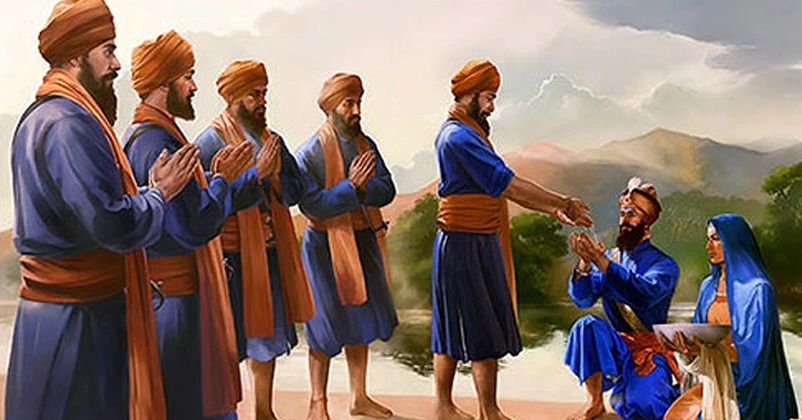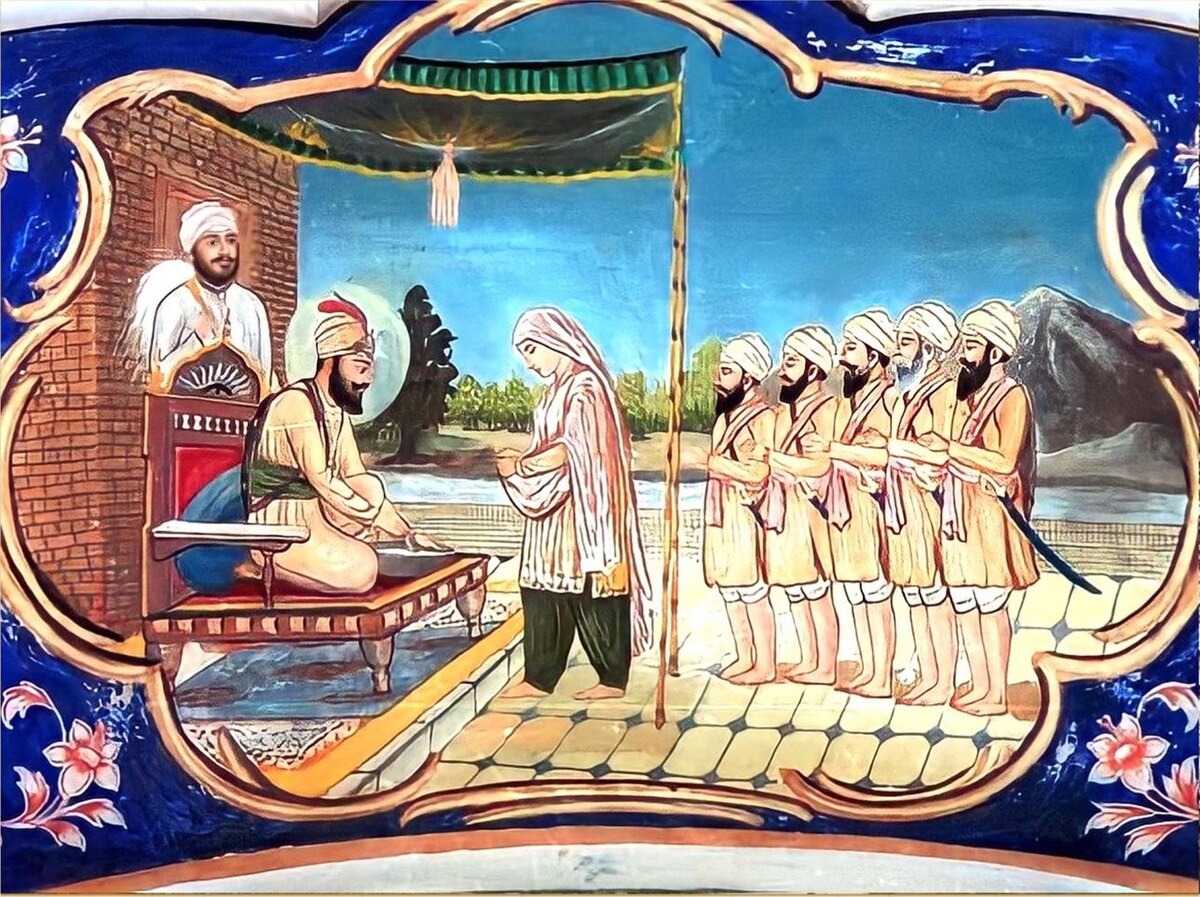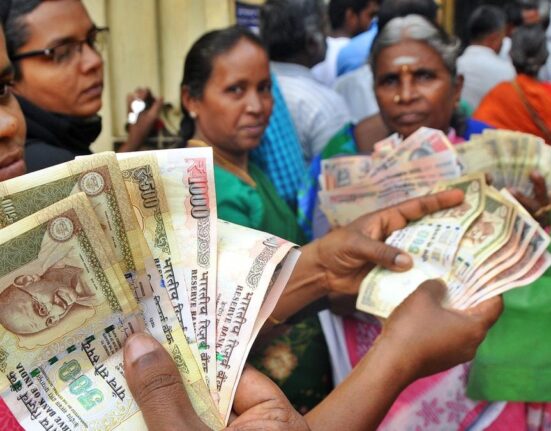परिचय
The founding of the Khalsa in 1699 by Guru Gobind Singh at Anandpur Sahib marks a transformative moment in Sikh and Indian history. Born in the crucible of religious persecution and political upheaval, the Khalsa redefined the Sikh community as a sovereign order of saint-soldiers. It brought sweeping spiritual, social, and political reforms, shaping Sikh identity and giving impetus to later struggles for justice and self-rule.

Historical Background
By the late 17th century, Sikhs and other non-Muslims in India faced severe religious oppression under Mughal Emperor Aurangzeb, including forced conversions, temple destructions, and heavy taxes like the jizya. Guru Gobind Singh’s father, Guru Tegh Bahadur, was executed by Aurangzeb in 1675 for defending religious freedom—an act that galvanized the Sikh community and solidified its commitment to resisting tyranny.
The Vaisakhi of 1699
पर March 30, 1699 (Vaisakhi Day), Guru Gobind Singh summoned Sikhs from across the subcontinent to Anandpur Sahib. In front of the enormous gathering, he astonished the crowd by appearing with a drawn sword and demanding a volunteer willing to sacrifice his head for the cause of faith and righteousness.
One after another, five volunteers stepped forward: Daya Ram, Dharam Das, Himmat Rai, Mohkam Chand, and Sahib Chand. Each was taken by the Guru into a tent; he reappeared five times, each time alone with a bloodstained sword, before finally revealing all five alive and well to the throng. These volunteers became known as the Panj Pyare (“Five Beloved Ones”), the first initiates of the Khalsa.
Amrit Ceremony and the Birth of a New Order
Guru Gobind Singh prepared “Amrit” (holy nectar) by stirring water and sugar in an iron bowl with a double-edged sword, reciting scriptures as he did so. He administered this Amrit to the Panj Pyare through a ceremony called khanda di pahul, inaugurating the order of Khalsa—a brotherhood of equals bound by spiritual discipline, dedication, and the willingness to defend justice.
Extraordinarily, Guru Gobind Singh then asked to be initiated by the Panj Pyare himself, thus making the leader accountable to the collective and symbolizing true equality. All initiates adopted the surname Singh (“lion”) for men and Kaur (“princess”) for women, breaking from caste barriers and forging a new, egalitarian identity.
Code of Conduct and The Five Ks
Members of the Khalsa took an oath to uphold a strict behavioral code (Rahit):
- Defend the innocent and the weak.
- Reject all forms of caste, creed, and superstition.
- Shun intoxication, tobacco, and adultery.
- Remain distinct by maintaining the Five Ks:
- Kesh (uncut hair)
- Kangha (wooden comb)
- Kara (iron bracelet)
- Kirpan (sword)
- Kachera (short breeches)
This spiritual discipline was combined with martial readiness, marking Sikhs as “saint-soldiers” committed to both contemplation and action.
Social, Spiritual, and Political Impact
- Equality and Brotherhood: The creation of the Khalsa abolished the oppressive caste system and untouchability, welcoming Sikhs from all backgrounds into a single brotherhood without distinction. This inclusivity elevated marginalized communities to leadership roles.
- Distinct Sikh Identity: The Khalsa’s external symbols, code of conduct, and the suffixes Singh and Kaur created a clear identity distinct from both Hindus and Muslims.
- Spiritual Revolution: By democratizing spiritual and temporal leadership—bypassing old priestly intermediaries—Guru Gobind Singh created a robust, disciplined, and unified Sikh community.
- Resistance to Oppression: Born in opposition to Mughal persecution, the Khalsa emerged as a militant force dedicated to defending religious freedom and the rights of all people—a commitment later embodied in the rise of Sikh military power under Banda Singh Bahadur and, subsequently, Maharaja Ranjit Singh.
- Political Transformation: The Khalsa became the core of Sikh resistance against Mughal and later Afghan rule, eventually forming the nucleus of the powerful Sarkar-i-Khalsa (Sikh Empire).
Legacy and Celebration
Today, Vaisakhi (April 13/14) is celebrated as the “birth day” of the Khalsa, honoring its ideals of courage, justice, and equality. The Khalsa continues to inspire Sikhs and non-Sikhs alike—a global brotherhood and sisterhood standing for spiritual discipline, social inclusivity, and the defense of justice in the world.

Interesting Facts
- Guru Gobind Singh was both the inaugurator and the first initiated member of the Khalsa, highlighting the ideal of collective leadership.
- The “Panj Pyare” included men from different castes and regions, exemplifying the rejection of social hierarchies.
- The Five Ks remain mandatory for all fully initiated Khalsa Sikhs to this day.
- The modern Sikh salutation, “Waheguru Ji Ka Khalsa, Waheguru Ji Ki Fateh” (“The Khalsa belongs to God, victory belongs to God”), originated with the founding of the Khalsa.
निष्कर्ष
The foundation of the Khalsa in 1699 CE by Guru Gobind Singh transformed Sikhism into a cohesive, dynamic, and resilient force for spiritual and temporal justice. It laid the enduring foundation for Sikh identity and defined a tradition of sacrifice, equality, and standing resolutely against injustice—principles that continue to resonate across the world.








इस बारे में प्रतिक्रिया दें